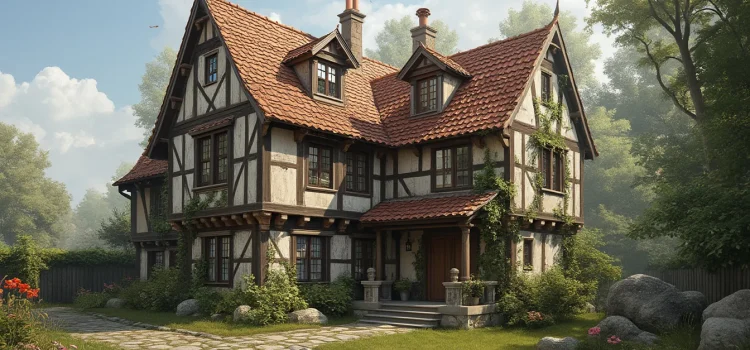
How did our ancestors make the shift from nomadic life to permanent homes? What can we learn about human history by exploring the changing form and function of houses throughout time?
The evolution of houses tells us more about our past than just architectural preferences. In his book At Home, Bill Bryson reveals how homes transformed from basic shelters into comfortable living spaces, with changing building materials, room layouts, and garden designs reflecting broader societal shifts.
Keep reading to discover how chimneys created privacy, why the middle class revolutionized comfort, and how technological innovations transformed both indoor and outdoor living spaces.
The Evolution of Houses
When we think of history, we often think of major events such as wars, elections, or revolutions. But Bryson points out that most of history is made up of regular people living their daily lives—eating meals, working, and sleeping at home. Since so much of history took place within them, our houses hold clues about the lifestyles of our ancestors.
Bryson explores the evolution of houses, from the origins of the first permanent settlements to the rise of comfortable living spaces.
(Shortform note: Today, the National Register of Historic Places protects over 96,000 historic properties across America. To qualify for this designation, a home must meet three requirements: It must be at least 50 years old, maintain its original appearance, and have historical significance—whether through a famous resident, important local events, or unique architecture. Recognizing and preserving historic homes allows us and future generations to experience the kinds of domestic spaces where human history unfolded, for years to come.)
The First Human Homes
Bryson explains that for most of human history, people lived as nomadic hunter-gatherers without permanent homes. The shift to permanent homes occurred during the Neolithic Revolution, which began around 12,000 years ago. During this period, people in different parts of the world began establishing settlements.
Many think that our ancestors began settling down to start farming, but Bryson says this isn’t true. Evidence shows that people established communities in permanent locations thousands of years before adopting agriculture. So why did our human ancestors abandon their nomadic ways? Researchers have proposed dozens of theories, ranging from climate change to people wanting to stay close to their dead or having a place to brew beer. However, no one knows for sure the real reasons humans decided to settle down in permanent homes.
Bryson points out that, at first, settling down brought many disadvantages compared to the hunter-gatherer lifestyle. People had poorer, less varied diets with fewer nutrients, and they died younger as a result. They were also more susceptible to diseases due to living in close quarters with other people and animals. Despite these drawbacks, the transition to settled life happened over millennia in multiple places around the world—from China to Egypt to Central America—often without any contact between these developing civilizations.
| Farming May Not Have Been a Conscious Choice While Bryson disputes whether farming was the reason humans decided to settle down, historian Yuval Noah Harari argues that the transition to agricultural life may not have been a conscious decision at all. In Sapiens, Harari suggests that humans ended up settling down in regions such as China, the Middle East, and Central America because plants like wheat grew easily there). Increased rainfall after the ice age ended led to more wheat growth, and as nomads consumed this wheat, they inadvertently spread its seeds, aiding its growth and encouraging them to linger near this food supply. Also, their practice of burning forests to attract animals for food created clearings that provided perfect conditions for wheat to flourish even more. For a consistent supply, wheat needed constant attention—humans had to clear rocks from fields, pull weeds, build irrigation systems, and guard against pests and animals. Over generations, temporary camps near these wheat fields slowly transformed into permanent settlements, as people spent more time tending their crops and less time hunting and gathering. Harari agrees with Bryson that despite providing food security, permanent settlements worsened people’s physical health; further, he says they took a toll on psychological health. The shift from nomadic life to farming created anxiety about the future. When people lived as nomads, they focused on immediate needs like finding today’s food or tonight’s shelter. But farming forced them to worry about events months or even years ahead—about planting and harvesting cycles, building up food reserves, and making future-oriented decisions. |
Materials Used to Build Houses
Bryson writes that the materials people used to build homes were shaped by many factors like availability, economics, style preferences, and technological capabilities. Throughout history, three materials were most commonly used:
Wood: In England, people used wood to construct homes for nearly a thousand years following the Roman Empire’s fall. However, homes required a lot of wood—a single farmhouse needed around 330 trees. As a result of heavy use, England’s forests quickly shrank, mostly disappearing by 1600 and forcing people to seek alternative building materials.
(Shortform note: Housing construction isn’t fully to blame for the depletion of England’s woodland. In Salt, Mark Kurlansky writes that the salt industry also consumed vast amounts of wood to fuel its salt-making process. Salt producers would boil brine (salty water) to extract salt, but this required enormous quantities of wood to maintain the fires. By the 1600s, this intensive process had stripped the English county of Cheshire—which led the nation’s salt industry—of most of its forests.)
Stone: Due to the shortage of wood, builders turned to using stone. While England had extensive limestone deposits, the high costs of mining and moving stone made it hard for many people to afford it—a mere 10-mile journey could double its price. For this reason, only wealthy people and institutions could afford stone buildings.
(Shortform note: Because it was so difficult and expensive to transport stone in medieval England, masons often dug their own local quarry pits instead of sourcing stone from distant quarries. They would dig these pits, sometimes 30 feet deep, right in backyards or in nearby fields. Once emptied, workers would fill them in and dig new ones elsewhere. However, if masons couldn’t set up local quarries, they preferred to transport stone via rivers, since this was cheaper than using roads. Through these methods, masons would extract different grades of stone for construction, using rough rubble for less-visible walls and high-quality ashlar stone for outer walls.)
Brick: Brick emerged as a more affordable alternative to stone, especially in London where clay was plentiful. In the late 1700s, people stopped using the material for a period of time due to changing tastes and a brick tax that made it unaffordable, but brick made a return during the Victorian era (the 1800s) because it could withstand the large amounts of coal smoke from heating and manufacturing, which damaged stone buildings.
(Shortform note: Coal smoke wasn’t the only reason brick buildings grew increasingly common in London. As early as 1605, King James I ordered that new houses be built from brick or stone to preserve timber for shipbuilding. Then, the Great Fire of 1666, which destroyed much of London, helped standardize brick usage. The 1667 Rebuilding Act required the outside of all buildings be made of brick or stone, and the massive rebuilding effort required after the fire meant thousands of new brick houses were constructed at once.)
The Rise of Private Spaces in Homes
Just as building materials changed throughout history, the internal layout of homes also changed. Bryson writes that before the 1330s, people lived mainly in one large room called the hall. The lord of the house sat on a raised platform called the dais, while servants and family members gathered in the same space with a central hearth providing warmth and cooking fires. These halls could only have one floor because the smoke from these fires would rise and fill upper spaces, making them unusable.
According to Bryson, the invention of effective chimneys allowed homes to expand vertically and have private rooms. While simple fireplaces existed earlier, they were only holes carved through stone walls that drew air poorly, generated little heat, and couldn’t be used in most homes, which were made of wood. With chimneys directing smoke outside, houses could finally grow both upward and outward. Wealthy families took advantage of this innovation by adding private spaces like bedchambers, parlors, and studies to their homes.
(Shortform note: Tests conducted by archaeologists suggest that central hearths were inefficient at keeping large halls warm. Digital simulations show that Viking-style halls could only maintain temperatures of about 43°F on winter days, and keeping a large hall even at this temperature required constant work. Someone would need to carry wood to the fire every 12.5 minutes, using about 55 tons of wood per season. Additionally, when researchers tested the air quality in these recreated halls, they determined that the smoke levels would likely have contributed to some health problems over time.)
| How the Hall Influenced Medieval Identity In Sapiens, Yuval Noah Harari writes that the single shared space of the hall contributed to a sense of collective identity in medieval society. He points out that in medieval times, people’s worth was determined by their reputation and place in society, not their individual identity. The hall reinforced this: With no private rooms, people lived in constant view of others, meaning everyone’s actions were visible and accountable to the community. As a result, people became intensely concerned with defending their reputation. So, the invention of the chimney not only expanded homes, but it also began shifting how people viewed themselves. Harari writes that when people have private rooms they can claim and control as their own, they naturally develop a stronger sense of individual identity. |
Home as a Place of Comfort
As homes evolved structurally, people’s expectations about what a home should be also began to shift. According to Bryson, people initially thought of their homes as functional spaces used merely for shelter. Most homes were bare and basic without effective heating and soft furnishings like carpets or cushioned chairs.
But the rise of Britain’s middle class in the 1700s transformed homes from basic shelters into places of comfort. As society grew wealthier through agricultural improvements and colonial trade, a new professional class emerged with both the money and the desire to make their homes more pleasant. These homeowners created a strong demand for fashionable furniture, carpets, mirrors, and decorative items. At the same time, new trade routes provided different types of wood for creating elegant furniture designs, and mass manufacturing made quality furniture available to more people.
(Shortform note: Architect Witold Rybczynski argues that the modern idea of home comfort evolved through layers, much like an onion. He writes that each era in history added new comfort features one at a time: first privacy and intimacy, then domesticity and pleasure, and finally efficiency and convenience. According to Rybczynski, comfort first emerged in the 17th-century Netherlands, where families established dedicated living spaces separate from work areas and that had better lighting and decorative furnishings, creating the first real sense of privacy and family life.)
The Transformation of Gardens and Outdoor Areas
Bryson writes that the spaces outside of homes have seen just as much change as those within. Outdoor spaces have transformed in two major ways:
1. Gardens transformed from artificial, geometric spaces to natural-looking landscapes. Bryson explains that early gardens were formal, with straight paths, clipped hedges, and colorful designs. Then, the Serpentine pond was created for Hyde Park in 1730, becoming the first manmade pond designed to look natural rather than rectangular or circular. This natural style gained momentum, popularizing gardens that blend with the landscape.
(Shortform note: While European gardens evolved toward natural designs, Japanese gardens moved in the opposite direction. During the Heian Era (794-1185), gardens were recreations of Buddhist paradise where nobles would go boating amid lush scenery. But when Zen Buddhism arrived in the late 13th century, gardens shifted toward simplicity. These gardens used precisely placed rocks and meticulously raked gravel to create spaces for meditation and reflection. Instead of trying to imitate nature directly, Zen gardens stripped nature down into simple, abstract forms.)
Byron writes that in the 18th and 19th centuries, people searched for new plants to fill these gardens. Plant hunters traveled to remote locations, risking their lives to discover new species that could be sold to European gardens and nurseries. This dramatically increased the variety of plants available to British gardeners from about 1,000 species in 1750 to over 20,000 a century later.
(Shortform note: Many of the exotic plants brought back by Victorian-era hunters became invasive species that now threaten Britain’s native ecosystems. Without natural predators from their home environments, plants like Japanese knotweed and Rhododendron ponticum have grown unchecked, overwhelming local species and causing extensive environmental damage. In fact, some of these introduced plants have become so problematic that it’s now illegal to let them spread in the wild.)
2. New technologies made lawns and gardens accessible to the middle class. Railways allowed people to move to the suburbs, which gave homeowners the space to take up gardening. Additionally, the invention of the lawnmower and chemical fertilizers made it possible for average homeowners to maintain lawns and healthy gardens. Bryson explains that before the lawnmower, only wealthy estates could maintain lawns by using sheep or teams of workers with scythes.
(Shortform note: While technology made lawns possible for everyone, this accessibility came with hidden costs that we’re only now beginning to understand. Maintaining lawns is resource-intensive: The average lawn uses as much water as 800 showers annually, as well as a lot of fertilizers, pesticides, and maintenance equipment. The shallow root systems of common lawn grasses also make them ineffective at preventing flooding or managing rainwater compared to native plants. This has led to a growing anti-lawn movement, with people now embracing lawns filled with wildflowers, clover, and native plants instead of purely grass.)






